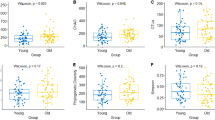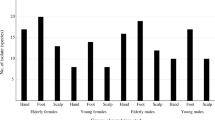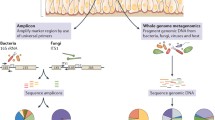Abstract
Skin is a major reservoir of bacterial pathogens in intensive care unit (ICU) patients. The aim of this study was to assess the skin bacterial richness and diversity in ICU patients and the effect of CHG daily bathing on skin microbiota. Twenty ICU patients were included during an interventional period with CHG daily bathing (n = 10) and a control period (n = 10). At day seven of hospitalization, eight skin swab samples (nares, axillary vaults, inguinal creases, manubrium and back) were taken from each patient. The bacterial identification was performed by microbial culturomics. We used the Shannon index to compare the diversity. We obtained 5,000 colonies that yielded 61 bacterial species (9.15 ± 3.7 per patient), including 15 (24.5 %) that had never been cultured from non-pathological human skin before, and three (4.9 %) that had never been cultured from human samples before. Notably, Gram-negative bacteria were isolated from all sites. In the water-and-soap group, there was a higher risk of colonization with Gram-negative bacteria (OR = 6.05, 95 % CI [1.67–21.90]; P = 0.006). In the CHG group, we observed more patients colonized by sporulating bacteria (9/10 vs. 3/10; P = 0.019) with a reduced skin bacterial richness (P = 0.004) and lower diversity (0.37, 95 % CI [0.33; 0.42] vs. 0.50, 95 % CI [0.48; 0.52]). Gram-negative bacteria are frequent and disseminated components of the transient skin flora in ICU patients. CHG daily bathing is associated with a reduction in Gram-negative bacteria colonization together with substantial skin microbiota shifts.

Similar content being viewed by others
References
Murillo N, Raoult D (2013) Skin microbiota: overview and role in the skin diseases acne vulgaris and rosacea. Future Microbiol 8:209–222. doi:10.2217/fmb.12.141
Grice EA, Kong HH, Conlan S, Deming CB, Davis J et al (2009) Topographical and temporal diversity of the human skin microbiome. Science 324:1190–1192. doi:10.1126/science.1171700
Larson EL, McGinley KJ, Foglia AR, Talbot GH, Leyden JJ (1986) Composition and antimicrobic resistance of skin flora in hospitalized and healthy adults. J Clin Microbiol 23:604–608
Vincent J-L (2003) Nosocomial infections in adult intensive-care units. Lancet 361:2068–2077. doi:10.1016/S0140-6736(03)13644-6
Duncan CN, Riley TV, Carson KC, Budgeon CA, Siffleet J (2013) The effect of an acidic cleanser versus soap on the skin pH and micro-flora of adult patients: a non-randomised two group crossover study in an intensive care unit. Intensive Crit Care Nurs Off J Br Assoc Crit Care Nurses 29:291–296. doi:10.1016/j.iccn.2013.03.005
Vernon MO, Hayden MK, Trick WE, Hayes RA, Blom DW et al (2006) Chlorhexidine gluconate to cleanse patients in a medical intensive care unit: the effectiveness of source control to reduce the bioburden of vancomycin-resistant enterococci. Arch Intern Med 166:306–312. doi:10.1001/archinte.166.3.306
Gao Z, Tseng C, Pei Z, Blaser MJ (2007) Molecular analysis of human forearm superficial skin bacterial biota. Proc Natl Acad Sci USA 104:2927–2932. doi:10.1073/pnas.0607077104
Fierer N, Hamady M, Lauber CL, Knight R (2008) The influence of sex, handedness, and washing on the diversity of hand surface bacteria. Proc Natl Acad Sci USA 105:17994–17999. doi:10.1073/pnas.0807920105
Wang Q, Garrity GM, Tiedje JM, Cole JR (2007) Naive Bayesian classifier for rapid assignment of rRNA sequences into the new bacterial taxonomy. Appl Environ Microbiol 73:5261–5267. doi:10.1128/AEM. 00062-07
Gao Z, Perez-Perez GI, Chen Y, Blaser MJ (2010) Quantitation of major human cutaneous bacterial and fungal populations. J Clin Microbiol 48:3575–3581. doi:10.1128/JCM. 00597-10
Kong HH (2011) Skin microbiome: genomics-based insights into the diversity and role of skin microbes. Trends Mol Med 17:320–328. doi:10.1016/j.molmed.2011.01.013
Hugon P, Lagier J-C, Robert C, Lepolard C, Papazian L et al (2013) Molecular studies neglect apparently gram-negative populations in the human gut microbiota. J Clin Microbiol 51:3286–3293. doi:10.1128/JCM. 00473-13
Lagier J-C, Million M, Hugon P, Armougom F, Raoult D (2012) Human gut microbiota: repertoire and variations. Front Cell Infect Microbiol 2:136. doi:10.3389/fcimb.2012.00136
Goodman AL, Kallstrom G, Faith JJ, Reyes A, Moore A et al (2011) Extensive personal human gut microbiota culture collections characterized and manipulated in gnotobiotic mice. Proc Natl Acad Sci USA 108:6252–6257. doi:10.1073/pnas.1102938108
Lagier J-C, Armougom F, Million M, Hugon P, Pagnier I et al (2012) Microbial culturomics: paradigm shift in the human gut microbiome study. Clin Microbiol Infect Off Publ Eur Soc Clin Microbiol Infect Dis 18:1185–1193. doi:10.1111/1469-0691.12023
Popovich KJ, Lyles R, Hayes R, Hota B, Trick W et al (2012) Relationship between chlorhexidine gluconate skin concentration and microbial density on the skin of critically ill patients bathed daily with chlorhexidine gluconate. Infect Control Hosp Epidemiol 33:889–896. doi:10.1086/667371
Grare M, Dibama HM, Lafosse S, Ribon A, Mourer M et al (2010) Cationic compounds with activity against multidrug-resistant bacteria: interest of a new compound compared with two older antiseptics, hexamidine and chlorhexidine. Clin Microbiol Infect 16:432–438. doi:10.1111/j.1469-0691.2009.02837.x
Climo MW, Yokoe DS, Warren DK, Perl TM, Bolon M et al (2013) Effect of daily chlorhexidine bathing on hospital-acquired infection. N Engl J Med 368:533–542. doi:10.1056/NEJMoa1113849
Evans HL, Dellit TH, Chan J, Nathens AB, Maier RV et al (2010) Effect of chlorhexidine whole-body bathing on hospital-acquired infections among trauma patients. Arch Surg Chic Ill 1960 145:240–246. doi:10.1001/archsurg.2010.5
Apisarnthanarak A, Pinitchai U, Warachan B, Warren DK, Khawcharoenporn T et al (2014) Effectiveness of infection prevention measures featuring advanced source control and environmental cleaning to limit transmission of extremely-drug resistant Acinetobacter baumannii in a Thai intensive care unit: An analysis before and after extensive flooding. Am J Infect Control 42:116–121. doi:10.1016/j.ajic.2013.09.025
Borer A, Gilad J, Porat N, Megrelesvilli R, Saidel-Odes L et al (2007) Impact of 4% chlorhexidine whole-body washing on multidrug-resistant Acinetobacter baumannii skin colonisation among patients in a medical intensive care unit. J Hosp Infect 67:149–155. doi:10.1016/j.jhin.2007.07.023
Lin MY, Lolans K, Blom DW, Lyles RD, Weiner S et al (2014) The effectiveness of routine daily chlorhexidine gluconate bathing in reducing Klebsiella pneumoniae carbapenemase-producing Enterobacteriaceae skin burden among long-term acute care hospital patients. Infect Control Hosp Epidemiol 35:440–442. doi:10.1086/675613
Seng P, Drancourt M, Gouriet F, La Scola B, Fournier P-E et al (2009) Ongoing revolution in bacteriology: routine identification of bacteria by matrix-assisted laser desorption ionization time-of-flight mass spectrometry. Clin Infect Dis 49:543–551. doi:10.1086/600885
Wang M, Karlsson C, Olsson C, Adlerberth I, Wold AE et al (2008) Reduced diversity in the early fecal microbiota of infants with atopic eczema. J Allergy Clin Immunol 121:129–134. doi:10.1016/j.jaci.2007.09.011
Grice EA, Segre JA (2011) The skin microbiome. Nat Rev Microbiol 9:244–253. doi:10.1038/nrmicro2537
Seifert H, Dijkshoorn L, Gerner-Smidt P, Pelzer N, Tjernberg I et al (1997) Distribution of Acinetobacter species on human skin: comparison of phenotypic and genotypic identification methods. J Clin Microbiol 35:2819–2825
Buehlmann M, Fankhauser H, Laffer R, Bregenzer T, Widmer AF (2010) The inguinal skin: an important site of colonization with extended-spectrum beta-lactamase-producing Enterobacteriaceae. Infect Control Hosp Epidemiol 31:427–428. doi:10.1086/651309
Thibault R, Graf S, Clerc A, Delieuvin N, Heidegger CP et al (2013) Diarrhoea in the ICU: respective contribution of feeding and antibiotics. Crit Care Lond Engl 17:R153. doi:10.1186/cc12832
Grice EA, Kong HH, Renaud G, Young AC, NISC Comparative Sequencing Program et al (2008) A diversity profile of the human skin microbiota. Genome Res 18:1043–1050. doi:10.1101/gr.075549.107
Karki S, Cheng AC (2012) Impact of non-rinse skin cleansing with chlorhexidine gluconate on prevention of healthcare-associated infections and colonization with multi-resistant organisms: a systematic review. J Hosp Infect 82:71–84. doi:10.1016/j.jhin.2012.07.005
Apisarnthanarak A, Yang Hsu L, Lim T-P, Mundy LM (2014) Increase in chlorhexidine minimal inhibitory concentration of Acinetobacter baumannii clinical isolates after implementation of advanced source control. Infect Control Hosp Epidemiol 35:98–99. doi:10.1086/674404
Naparstek L, Carmeli Y, Chmelnitsky I, Banin E, Navon-Venezia S (2012) Reduced susceptibility to chlorhexidine among extremely-drug-resistant strains of Klebsiella pneumoniae. J Hosp Infect 81:15–19. doi:10.1016/j.jhin.2012.02.007
Lai Y, Cogen AL, Radek KA, Park HJ, Macleod DT et al (2010) Activation of TLR2 by a small molecule produced by Staphylococcus epidermidis increases antimicrobial defense against bacterial skin infections. J Invest Dermatol 130:2211–2221. doi:10.1038/jid.2010.123
Acknowledgments
We acknowledge Georgette Grech and Isabelle Jousset for their technical assistance, and Anderson Loundou for reviewing the statistical methods. Sage products provided the single-use, no-rinse disposable cloths saturated with 2 % chlorhexidine gluconate.
Competing interests
The authors declare that they have no competing interests.
Authors’ contribution
LP, BLS, and DR conceived of the study and participated in its design. NC carried out the experiments, and drafted the manuscript. LP took care of the patients. NC, LP, PEF, DR and BLS analysed the data. LP, PEF, DR, and BLS helped to draft the manuscript. All the authors revised and approved the manuscript.
Author information
Authors and Affiliations
Corresponding author
Electronic supplementary material
Below is the link to the electronic supplementary material.
ESM 1
(DOC 135 kb)
Rights and permissions
About this article
Cite this article
Cassir, N., Papazian, L., Fournier, PE. et al. Insights into bacterial colonization of intensive care patients’ skin: the effect of chlorhexidine daily bathing. Eur J Clin Microbiol Infect Dis 34, 999–1004 (2015). https://doi.org/10.1007/s10096-015-2316-y
Received:
Accepted:
Published:
Issue Date:
DOI: https://doi.org/10.1007/s10096-015-2316-y




